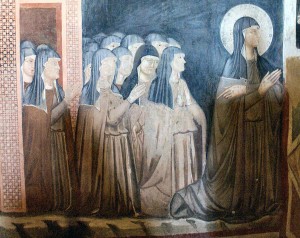By Elizabeth A. Lehfeldt (W&M Regular Contributor)
It is not often that my research is topical. Most people feign polite interest when I tell them I study sixteenth-century Spanish convents. But with the recent controversy over the Catholic Church’s scrutiny of the behavior and activities of American nuns, the subject of female monasticism has enjoyed an unprecedented timeliness.
My goal in this essay is not to enter the twenty-first century polemic; I’m much more comfortable in the sixteenth century. I would offer, however, the following observation: that certain assumptions and even stereotypes undergird the remarks of some of the participants in the current debate. And here is where history can be so useful. Arguably, we root some of our modern interpretations of nuns in what we think convents were like in the premodern period.
* Convents were clearinghouses for un-marriageable daughters. Driven by the evidence of high marital dowries and other socio-economic factors, we imagine that convents served a necessary social function as a refuge for families with too many daughters or daughters who weren’t competitive on the marriage market. This assertion crumples, however, in the face of the fact that most convents also required a dowry. These dowries were smaller than secular dowries, but not inconsequential. Further, this assumption must be reconciled against numerous and varied expressions of religious vocation. The vast majority of nuns felt a spiritual calling to live in monastic communities.
* Convents were hotbeds of sexual scandal. Having accepted the notion that most nuns didn’t want to be there in the first place and certainly didn’t willingly take vows of celibacy, it is not much of a leap to imagine that they rebelled through sexual transgressions. This fine tradition owes much to Boccaccio’s Decameron (14th century) and similar literature; anti-religious Enlightenment polemics (18th century); and even nineteenth century Protestant re-interpretations of nuns as deviant renegades. It bears, however, little resemblance to reality and tells us more about the gender and religious politics of each of these eras than it does about the actual behavior of nuns. Overall, nuns devoted themselves to intercessory prayer, liturgical responsibilities, and social services like teaching and nursing. They had little time or interest in deviant behavior.
Aside from correcting popular perceptions, these two lessons from the historical record should also offer us some challenges as we examine the lives of contemporary nuns. As Mary Gordon remarked in a 2002 article based on her interviews with practicing nuns, “people look at me suspiciously when I talk to them about the happiness of the nuns I’ve spoken to.”* We struggle to comprehend the lives of women—premodern or modern—who would choose this life for themselves. The popular image of the nun suggests that women would only do this against their will and that they would engage in rebellious, transgressive behavior as a consequence. We owe the nuns—of both history and the present day—a better understanding of their lives than that.
* Mary Gordon, “Women of God,” The Atlantic Monthly (January 2002), 61.
Elizabeth A. Lehfeldt is Chair and Professor of History at Cleveland State University. She writes on the history of gender in premodern Europe.

